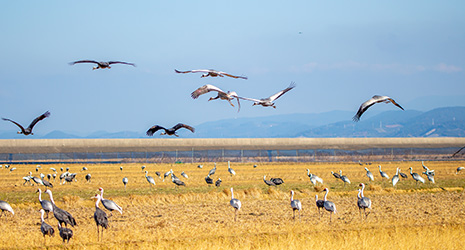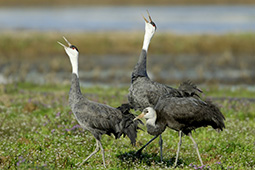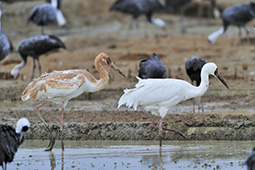February 2023
- English
- 日本語
Japan’s Internationally Important Wintering Habitat of Cranes

Cranes fly in from Siberia and northeastern China to winter in Izumi City, Kagoshima Prefecture 
White-naped cranes

Hooded cranes 
Adult and young endangered Siberian cranes

Izumi City in Kagoshima Prefecture, located on the southernmost tip of Kyushu in the southwestern part of the Japanese archipelago, is one of the world’s major wintering sites for cranes. The sight of over ten thousand cranes in Izumi City is a distinctive winter attraction.

Along the coast of Izumi City in the northwestern part of Kagoshima Prefecture stretches a vast expanse of paddy fields on land reclaimed from tidal flats. Each year in October, more than ten thousand cranes fly from Siberia and northeastern China to winter here. The area is Japan’s largest crane wintering grounds and one of the most important wintering habitats of cranes in the world. The sight of cranes foraging for food in the peaceful rice fields and wheeling gracefully through the air with outstretched wings is a distinctive Izumi City winter attraction.
“Cranes are said to have first migrated to Izumi in the late seventeenth century, when the daimyo, or the feudal lord, who ruled the area at that time began the land reclamation work,” says Hori Masanobu, Director of the Izumi Municipal Crane Museum “Crane Park Izumi” and Head of Izumi City Ramsar Promotion Office. “The rule was that only the shogun and daimyo were allowed to capture cranes back then, so the practice of hunting them was strictly prohibited.”
When the era of samurai rule came to an end in the second half of the nineteenth century and the ban on hunting cranes was lifted, it is said that for a time not a single crane came to Izumi. However, in 1895 the crane was designated a legally protected species, followed by its designation as a protected national monument in 1921 and as a special natural monument in 1952, after which the number of cranes migrating to the area steadily increased.

“The Kagoshima Crane Protection Society has been responsible for the protection of cranes in Izumi since its formation in 1962. The cooperation of local farmers and youngsters has been crucial to the success of these activities,” says Hori. “An example is the crane count survey by a junior high school “Crane Club.” Over a period of more than 60 years since the survey was first conducted in 1960, members from three generations of some families have taken part in the initiative—parents, children, and grandchildren. Also, in the eastern reclaimed land where the cranes roost, rice cultivation has been brought forward. So instead of the rice being harvested in October as would normally be the case, the rice harvest for human consumption is now completed in August. This means that come October when the cranes arrive, the rice plants will have grown again from the stubble left after the first harvest, providing the birds with a good source of food.”
Today, Izumi City contains a Wildlife Protection Area* of 867 hectares. During the winter months, the Kagoshima Crane Protection Society rents some of the rice fields from farmers in this area and adds shallow water to create secure nighttime artificial roosts. A member of the Society is responsible for monitoring the area and carries out tasks such as feeding the cranes in the early morning.
Over the years, these initiatives have borne fruit, as evidenced by the fact that more than ten thousand cranes have flown to Izumi for twenty-six seasons straight from 1997 through 2022. Cranes that can be typically observed here are the endangered hooded crane and white-naped crane. Almost 90 percent of the approximately 16,000 global population of hooded cranes gather here. To date, of the fifteen species of crane in the world, seven species and one hybrid species have flown to Izumi. The Izumi Wintering Habitat of Cranes (478 ha) was listed as a wetland under the Ramsar Convention** in November 2021. In November of the following year, Izumi City and Niigata City became the first municipalities in Japan to be certified as Ramsar Sites under the Ramsar Convention.

“I’ve heard that crane sightings in places such as Siberia where they spend their summer are rare due to the vastness of the land. Places like Izumi where you can observe so many cranes in close proximity to human habitation are exceptional. That’s why in winter many birdwatchers on group tours come to Izumi from overseas,” says Hori.
Beloved by locals and domestic and overseas tourists alike, the cranes spend almost six months in the mild climate of Izumi giving their wings plenty of rest, before migrating in the months of February and March to more northern lands.
* An area where capture of wildlife is prohibited in order to increase the wildlife population
** The Ramsar Convention is a treaty for the conservation of important wetlands and their fauna and flora. Ramsar wetlands are wetlands designated in accordance with the international criteria stipulated by the Convention.

